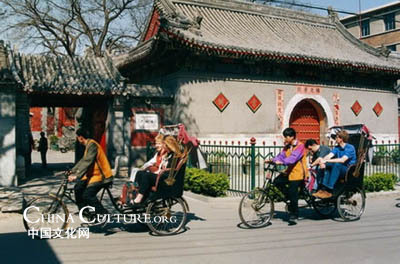![]()
|
|
|
 |
Beijing Hutong Tour2009-11-10 14:35:00 From: chinaculture.org
The Beijing Hutong (old lane) areas have a very special and important position in the rich history and culture of Beijing.  The alleys give a wonderful glimpse into the world of yesterday in Beijing. While visiting the Beijing Hutong, you can appreciate the dramatic changes that the rest of Beijing has undergone. You can see evidence of the history of Beijing, experience the old way of life and experience traditional Beijing culture. Longer Beijing tours usually include a visit to a hutong area. What Hutongs are The Beijing Hutong is made up of lanes or alleys formed by lines of pre-modern siheyuan, four-sided compounds with houses around a courtyard. Low-rise "old Beijing" is a striking contrast to the apartment blocks of "new Beijing". Beijing road classification was once as follows: 36-foot-wide road was called a standard street, a 18-foot-wide one was a small street and a 9-foot-wide lane was named a hutong. In fact, the Beijing hutong are unclassifiable by the traditional standard, ranging from 40 centimeters to 10 feet in width. The longest hutong has more than 20 turns. It is easy to get lost in the maze of winding lanes that is the hutong, with the gray-tiled houses and deep alleys crossing each other, all identical in appearance, with many blind hutongs or cul-de-sacs. History of the Hutongs Hutongs were first named as such in the Yuan Dynasty (1271-1368), with its Mongolian rulers having an influence on the Chinese language. However, siheyuan or quadrangles have probably been around much longer. The Chinese word 'hutong' means lane and is curiously made up from the word for beard 'hu' and the word for same, 'tong', which makes no sense, and therefore is probably an attempt to represent a word from another language with a rough phoneticization using Chinese characters. The word hutong originates from the word hottog which means well; in Mongolian. Villagers used to dig a well and take up residence around it. |
|
|
||||||||||||